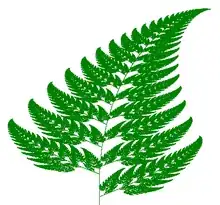As requested, I'm posting my comment as an answer here:
The Wikipedia link provided by Jim, with respect to "L-systems" lists, as an open problem:
"Given a structure, find an L-system that can produce that structure."
It is a great question, though! The same link provided by Jim (on L-systems), lists a book reference, including a link to the book in pdf format that you might be interested in: Przemyslaw Prusinkiewicz, Aristid Lindenmayer - Algorithmic Beauty of Plants (for URL: algorithmicbotany.org/papers/#abop). There you can download any/all of the following pdfs:
Chapter 1 - Graphical modeling using L-systems (2Mb; LQ, 1Mb)
Chapter 2 - Modeling of trees (4Mb; LQ, 300kb)
Chapter 3 - Developmental models of herbaceous plants (1.7Mb; LQ, 500kb)
Chapter 4 - Phyllotaxis (2.5Mb; LQ, 500kb)
Chapter 5 - Models of plant organs (1.2Mb; LQ, 300kb)
Chapter 6 - Animation of plant development (650kb; LQ, 160kb)
Chapter 7 - Modeling of cellular layers (3.7Mb; LQ, 800kb)
Chapter 8 - Fractal properties of plants (1.2Mb; LQ, 300kb)
There are also many additional links and resources that may be of interest, which you can access directly from the Wikipedia entry.

